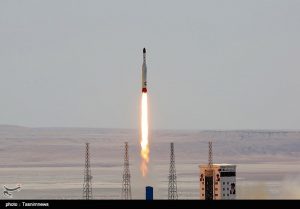On Sunday, an Iranian space launch attempt failed to properly insert its payload into orbit, state television reported. Iran said that carried out a launch of its Simorgh space launch vehicle “successfully” on Sunday, but that the launcher failed to deliver its payload — the Zafar satellite — into orbit.
The launch took place at 7:15 p.m. local time in Iran’s Semnan province, at the Imam Khomeini Spaceport. The site is approximately 230 kilometers southeast of Tehran, the Iranian capital. An Iranian spokesperson said the launch mission was successful “90 percent of the way” and that the launch vehicle reached an altitude of 540 kilometers.
“The Simorgh [launcher] successfully propelled the Zafar satellite into space,” said Ahmad Hosseini, a spokesperson for the Iranian Defense Ministry’s space projects. “Unfortunately, in the final moments the carrier did not reach the required speed” to put it into orbit, he added. “God willing with improvements made in future launches this part of the mission will be done as well,” suggesting that further launchers may take place.
“Stage-1 and stage-2 motors of the carrier functioned properly and the satellite was successfully detached from its carrier, but at the end of its path it did not reach the required speed for being put in the orbit,” Hosseini added.
Iran’s Information and Communications Technology Minister Mohammad Javad Azari Jahromi took to Twitter to noted that Iran has “more Upcoming Great Iranian Satellites!” Iran attempted to launch two satellites in January and February 2019. Both attempts failed.
The U.S. government has claimed that Iran’s space activities are a cover for long-range ballistic missile deployment. In a statement released September 2019 designated Iran’s space program, the U.S. State Department noted that “Space launch vehicle (SLV) technologies, such as those developed by Iran’s space program, are virtually identical and interchangeable with those used in ballistic missiles.”
While technologies between missiles and space launch vehicles are related, countries like North Korea have pursued alternative technological pathways to intercontinental-range ballistic missiles than that used in space launch vehicles.
There are examples of ballistic missiles being repurposed as space launchers, including the R-7, the first intercontinental-range ballistic missile developed by the Soviet Union, which was eventually repurposed to launch satellites, including Sputnik-1, the first artificial satellite.
The United States has designed the Iran Space Agency (ISA), the Iran Space Research Center (ISRC), and the Astronautics Research Institute (ARI) under sanctions pursuant to Executive Order 13382, which “targets proliferators of weapons of mass destruction (WMD) and WMD delivery systems and their supporters.”

































